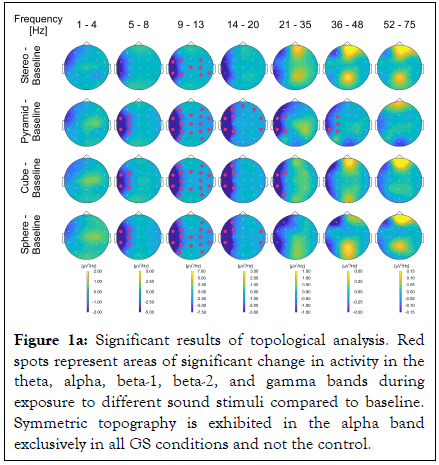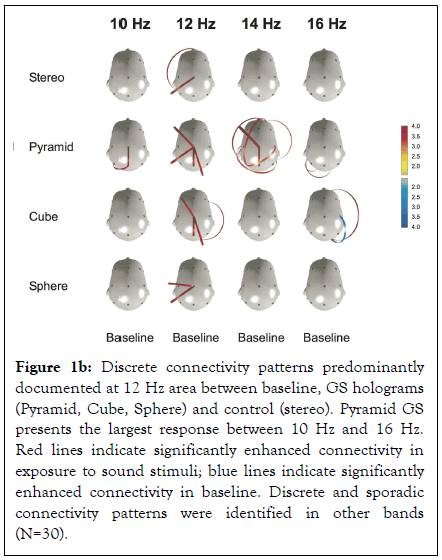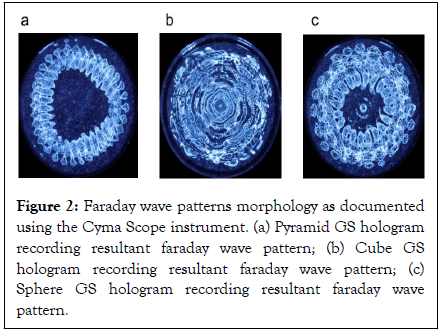International Journal of Physical Medicine & Rehabilitation
Open Access
ISSN: 2329-9096
ISSN: 2329-9096
Mini Review - (2024)
Emerging techniques in sound holography demonstrate its potential for substance manipulation, highlighting its advantages in resource utilization. Ultrasonic and audible sound holograms were demonstrated in recent studies to have encouraging effects on micro particle manipulation, brain wave activity patterns and markers of the autonomic nervous system. Sound holography is indicated to support the configuration of attainable and effective applications for health and rehabilitation, namely cell fibers bio printing, tissue engineering, improved neuroplasticity and stress regulation.
Sound holography; Ultrasound; Spatial sound; Geometric sound; Neuroplasticity; Faraday wave
Sound is a pressure wave fluctuating between low and high radiation patterns across spectrums. As such, a sound field contains its spectral and topographic characteristics. Recent studies suggest that ultrasonic and audible sound holograms provide efficacious applications for cell patterning, tissue regeneration, neurological plasticity, and emotional regulation. The demonstrated potential of sound holography to facilitate effective, case specific and non-invasive reconditioning, suggests a novel approach to physiological and emotional rehabilitation one that is periodic and topographic simultaneously. Here we discuss recent highlights in sound holography research and their possible applications for physiologic, neurologic and emotional regulation.
In a recent study we reported that immersion in audible 3D Geometric Sound (GS) holograms of the shapes pyramid, cube and sphere significantly affected brain wave activity patterns, physiological biomarkers and faraday wave pattern morphology, compared to baseline and control conditions [1]. All stimuli played an identical sound sample of octave interval between 272.2 Hz and 544.4 Hz, and were measured under exact conditions. Significant effects were recorded in brain wave activity patterns in most frequency bands. Alpha band presented a predominant effect with symmetric topology, discrete connectivity patterns, and power decrease across the largest cluster (Figures 1a and 1b).

Figure 1a: Significant results of topological analysis. Red spots represent areas of significant change in activity in the theta, alpha, beta-1, beta-2, and gamma bands during exposure to different sound stimuli compared to baseline. Symmetric topography is exhibited in the alpha band exclusively in all GS conditions and not the control.

Figure 1b: Discrete connectivity patterns predominantly documented at 12 Hz area between baseline, GS holograms (Pyramid, Cube, Sphere) and control (stereo). Pyramid GS presents the largest response between 10 Hz and 16 Hz. Red lines indicate significantly enhanced connectivity in exposure to sound stimuli; blue lines indicate significantly enhanced connectivity in baseline. Discrete and sporadic connectivity patterns were identified in other bands (N=30).
Notably, the observed decrease in power amplitude validates that connectivity patterns are of high significance. GS was shown to positively impact regulation of the Autonomic Nervous System (ANS), reduce heart rate and blood pressure and increase relaxation and emotional wellbeing. Across analysis paradigms response varied predominantly according to factorshape, pyramid GS hologram yielded the most significant results.
Results suggest that regardless of spectral information, topographic information of a sound hologram can employ distinct effects. Thus, the observed enhanced physiologic effect is derived from the spatial configuration encoded within the sound hologram. Such effects could promote enhancement of a preferred outcome in different rehabilitation paradigms. For example, connectivity patterns demonstrate discrete response during exposure to each sound hologram. Upon further investigation, shape specific connectivity patterns could be identified to establish plasticity in desired regions and facilitate personalized rehabilitation. Major Depressive Disorder (MDD) is linked to neurological patterns such as decreased alpha symmetry [2,3]. Increased alpha symmetry during exposure to GS holograms could suggest potential advantages for MDD rehabilitation. ANS and emotional response following exposure to the sound stimuli are in agreement with documented effects of relaxation practices, such as meditation and audible sound interventions on stress regulation [4-7]. Thus, results indicate audible sound holograms could be emotionally beneficial, as they integrate the merits of sound spectral properties. In accordance with observations on physiological and emotional response, Faraday wave pattern morphology exhibited distinct patterns associated with the presented holographic geometry. Specifically, pyramid GS resulted in a triangular pattern, cube GS resulted in a square pattern and sphere GS resulted in a circular pattern (Figures 2).

Figure 2: Faraday wave patterns morphology as documented using the Cyma Scope instrument. (a) Pyramid GS hologram recording resultant faraday wave pattern; (b) Cube GS hologram recording resultant faraday wave pattern; (c) Sphere GS hologram recording resultant faraday wave pattern.
All morphology patterns were documented in a circular cuvette on the Cyma scope instrument which converts acoustic periodicities into water wavelet periodicities. Notably, Faraday wave discrete pattern morphology is in alignment with physiologic analysis, indicating a causal relationship characterized by a specific, shape-dependent response, independent of frequency. Here we propose that the effects demonstrated in our study may hold relevance to the emerging understanding and utilization of sound holography in medical rehabilitation practices.
In principle, acoustic holography is similar to optical holography, where each fragment carries data representing the object in its entirety and contains an angle-specific image. Thus, fragments of a sound field encapsulates its spectral and topographic information [8]. Accordingly, a recording of a 3D sound hologram includes characteristics of its spatial properties projected in space. Mueller and Sheridon reported sound hologram observations as early as 1966. A submerged metal rod with the letter E inscribed on it was exposed to ultrasound waves and observed using laser optical reconstruction. The hologram was created by deformation of the water surface caused by sound radiation pressure [9]. Kassewitz et al., reported that cymascopic analysis of a dolphin echolocation beam recordings produced visual images of submerged objects presented to the dolphin. In initial observations the researchers documented objects such as a flower pot, and subsequently successfully captured the full silhouette and surface features of a person. The researchers indicate that point specific recording of the echo beam is sufficient for image reconstruction, as each fragment of the sound field contains quasi-holographic sonic data of its entirety [10]. Thus, each part of the recorded sound field encapsulates its spectral and topographical characteristics. Similarly, observations of Faraday wave pattern morphology demonstrate that a stereo recording of a 3D GS hologram displays characteristics of its spatial properties. The images are hypothesized to encapsulate sonic reflections from the entire hologram periphery. These observations demonstrate imprinting of audible sound topographic information on substances. It should be noted that the images captured on the cyma scope instrument reveal a 2D depiction of the upper wave pattern imprinted on the water membrane. However, the pattern is presumed to be 3 dimensional inside the water cuvette and the lack of adequate documentation paradigm infringes its display.
Ultrasound holograms-applications for particle organization and tissue patterning
While ultrasound is a well employed practice for imaging and its use for particle manipulation have been previously demonstrated in the literature the advantages of organizing substances using an ultrasonic sound hologram is an emerging practice [11]. Ultrasound Directed Self Assembly (DSA) employs external ultrasonic wave fields on substances for their manipulation. Generally, DSA methods utilize external wave fields to create intricate interactions. Ultrasound DSA is advantageous to other methods employing electric or magnetic wave fields, as it utilizes sound’s pressure energy and does not depend on charge properties of the manipulated particles [12]. Melde et al., reported the recreation of 3D arbitrary shapes using sound holograms leveraging compact holographic ultrasound fields. The study successfully demonstrates the construction of complex 3D objects using micro particles, hydrogel beads and biological cells. The authors note that sound holography is the first reported method to result in a single step process compared to other methods using mediums such as light. Their novel method to realize 3D assembly of matter uses a combination of ultrasonic holograms, and does not require counter propagating waves or phase discontinuities to trap particles in 3D. The study indicates that the documented volumetric data stand as proof for the successful reconstruction of the holographic topography. The authors suggest this method could be used for tissue engineering and additive manufacturing [13]. Armstrong et al., reported that a brief application of ultrasound standing wave is successful in patterning myoblast populations in muscle cell tissue in vitro. Ultrasound patterning was found to significantly improve myofibrillogenesis and promote muscle fibers formation. Notably, the authors indicate a frequency dependent response and highlight the augmentation of this method to other bio printing strategies, as it does not constrain to limited resolution or time consuming pattern molding [14]. These indications could suggest a prodigious approach to case-specific cell and tissue engineering, highlighting an efficacious targeted employment to obtain desired results.
Sound holography implications on resource utilization
It is generally agreed that faraday wave pattern morphology following audible sound and mechanical excitation in fluid reservoirs is determined by the monitored frequency and geometry of the examined medium [15-17]. Prisbrey et al., reported the number of transducers and their geometric arrangement is essential for successful 3D user-specified patterning of nanoparticles in a fluid reservoir following ultrasound excitation [12]. Developments in sound holography posit that substance organization could be directly affected by the spatial topography encoded in a sound hologram, potentially independent of the monitored frequency and medium geometry. Hence, frequency might regulate particle mechanical entrained response, while spatial information may dictate its geometric topography. It should be noted that different physiologic mechanisms were found to be regulated by specific frequencies. Accordingly, in many frequency-based interventions, varied and distinct effects are reported following excitation by discrete frequencies [18,19]. A review paper by Bartel et al., on the mechanisms through which sound impacts human health emphasizes discrete effects caused by various sound and mechanical frequencies [20]. For example, 40 Hz is reported, among others, to impact cell differentiation, improve Alzheimer and Parkinson disease symptoms and increase cortical synaptic activity [21-25]. Muscle treatment was found to benefit from particular resonance frequencies, and wide dynamic range spinal neurons, which are entrained to vibratory frequencies below 80 Hz, are indicated to play a role in pain regulation [26,27]. Such indications demonstrate the potential in harnessing sound holograms with distinct frequencies to achieve desired and case specific results in different rehabilitation paradigms.
The studies discussed here demonstrate that audible sound and ultrasound holograms are indicated to efficiently support cell fibers bio printing, tissue engineering, and enhance neurological plasticity. In addition, sound spectral information is reported across studies and methodologies to employ discrete effects on physiologic mechanisms, emotional well-being and stress regulation. Notably, stress is known as a key factor to hamper successful rehabilitation processes. Results signify a form of physiologic entrainment derived by a sound field pressure force combining its spectral and topographic properties. Future studies should further inspect these implications in order to validate a non-invasive and effective employment of sound holography. A method that could verify indications of the quasiholographic properties of sound could benefit configurable and attainable solutions for health applications to enhance physiologic and neurologic plasticity.
As ultrasound holograms were found to effectively impact the organization of different substances including biological cells in a one-step procedure. Research on audible sound demonstrates a comparable holographic effect in faraday wave pattern morphology, corresponding with shape-specific effect on brainwave activity patterns and physiologic response. The topographic information encoded within a sound hologram is indicated to imprint a scalar pattern independently of the geometric boundary of the observed medium or its spectral characteristics. Results demonstrate the advantages of sound holography for cell fibers bio printing, tissue engineering, enhanced neurological plasticity, improved emotional well-being and stress regulation.
[Crossref] [Google Scholar] [PubMed]
[Crossref] [Google Scholar] [PubMed]
[Crossref] [Google Scholar] [PubMed]
[Crossref] [Google Scholar] [PubMed]
[Crossref] [Google Scholar] [PubMed]
[Crossref] [Google Scholar] [PubMed]
[Crossref] [Google Scholar] [PubMed]
[Crossref] [Google Scholar] [PubMed].
[Crossref] [Google Scholar] [PubMed]
[Crossref] [Google Scholar] [PubMed]
[Crossref] [Google Scholar] [PubMed]
[Crossref] [Google Scholar] [PubMed]
[Crossref] [Google Scholar] [PubMed]
[Crossref] [Google Scholar] [PubMed]
[Crossref] [Google Scholar] [PubMed]
[Crossref] [Google Scholar] [PubMed]
[Crossref] [Google Scholar] [PubMed]
Citation: Geffen R (2024). Applications of Sound Holography in Health and Rehabilitation. Int J Phys Med Rehabil. 12:S24.002.
Received: 09-Aug-2024, Manuscript No. JPMR-24-33452; Editor assigned: 12-Aug-2024, Pre QC No. JPMR-24-33452; Reviewed: 26-Aug-2024, QC No. JPMR-24-33452; Revised: 02-Sep-2024, Manuscript No. JPMR-24-33452; Published: 09-Sep-2024 , DOI: 10.35248/2329-9096.24.S24.002
Copyright: © 2024 Geffen R. This is an open-access article distributed under the terms of the Creative Commons Attribution License, which permits unrestricted use, distribution, and reproduction in any medium, provided the original author and source are credited.